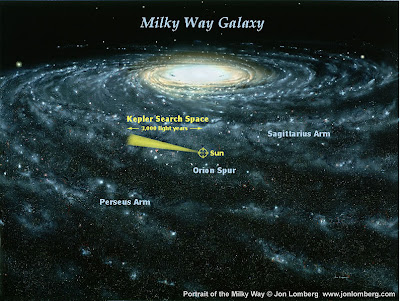
Kepler Mission search area.(Milky Way portrait by space artist Jon Lomberg.)
Most of the extrasolar planets detected so far by other projects are giant planets, mostly the size of Jupiter and bigger. Kepler is designed to look for planets 30 to 600 times less massive, closer to the order of Earth's mass. The method used, the transit method, involves observing repeated transit of planets in front of their stars, which causes a slight reduction in the star's apparent magnitude, on the order of 0.01% for an Earth-sized planet. The degree of this reduction in brightness can be used to deduce the mass of the planet, and the interval between transits can be used to deduce the size of the planet's orbit and estimate its temperature.The random probability of a planetary orbit being along the line-of-sight to a star is the diameter of the star divided by the diameter of the orbit. For an Earth-like planet at 1 AU transiting a solar-like star the probability is 0.465%, or about 1 in 215. At 0.72 AU (the orbital distance of Venus) the probability is slightly larger, at 0.65%; such planets would be Earth-like if the host star is a late G-type star such as Tau Ceti. In addition, because planets in a given system tend to orbit in similar planes, the possibility of multiple detections around a single star is actually rather high. For instance, if an alien Kepler-like mission observed Earth transiting the Sun, there is a 12% chance of also seeing Venus transit.The Kepler Mission has a much higher probability of detecting Earth-like planets than the Hubble Space Telescope, since it has a much larger field of view (approximately 10 degrees square), and will be dedicated for detecting planetary transits. The Hubble Space Telescope is, in contrast, used to address a wide range of questions and rarely looks continuously at just one starfield. The Kepler Mission is designed to observe 100,000 stars simultaneously, measuring variations in their brightness every 30 minutes. This provides a much better chance for seeing a transit. In addition, the 1 in 215 probability means that if 100% of stars observed had the exact same diameter as the Sun, and each had one Earth-like terrestrial planet in an orbit identical to that of the Earth, Kepler would find about 465 of them. The mission is therefore ideally suited to determine the frequency of Earth-like planets orbiting other stars.Since Kepler must see at least three transits to be sure the dimming was caused by a planet, and since larger planets give a signal that is easier to check, scientists expect the first reported results will be larger Jupiter sized planets in tight orbits. These could be reported after only a few months of operation. Smaller planets, and planets further from their sun will take longer, and discovering planets comparable to Earth is expected to take three years or longer.Data from the mission will also be used for studying variable stars of various types and performing asteroseismology, particularly on stars showing solar-like oscillations.
Assumptions Used to Estimate the Results:
The strength of the Kepler Mission is its ability to address the unexpected with its capability to monitor a large enough sample of stars to obtain a statistically meaningful survey of terrestrial and larger planets with orbital periods from a few days to over a year. We can only estimate the expected results based on possible scenarios, since we have no knowledge of the frequency and distribution of terrestrial planets outside of our solar system. The mission has been designed to gather enough information so that even a null result would be meaningful and indicate that terrestrial planets were rare.
To quantitatively estimate the potential of the results for the Kepler Mission, we assume that:
1.One-hundred thousand main-sequence stars are monitored;
2.The average white-light variability of most F-, G- and K-main-sequence stars on the time scale of a transit is similar to that of the Sun after excluding the most active 25% of the dwarf stars in the FOV;
3.Most main-sequence stars, including binaries, have terrestrial planets in or near the habitable zone;
4.On an average two Earth-size or larger planets exist in the region between 0.5 and 1.5 AU, based on our solar system and the accretion model of Wetherill (1996);
5.The transit probability for planets in or near the HZ is 1/2% per planet;
6.The transit is near-grazing in a 1 year orbit;
7.Each star has one giant planet in an outer (jovian-like) orbit;
8.On average, 1% of the main-sequence stars have giant planets in orbits <1 week and comparable numbers of giant planets in orbits of 1 week to 1 month and 1 month to 1 year;
9.The detection efficiency is 84% with an expectation of one false detection; and
10.The mission life time is four years.
No comments:
Post a Comment